I will be the first to admit that the majority of this information was liberated from the Korean Government webpages located at: https://www.sanghun.go.kr/nation/information/posangInfo6.do. I took the opportunity to show this information here because, unless you are familiar with the Korean language, it can be difficult to find.
Korean documents are done by professional calligraphers. This makes translating them somewhat difficult, especially for a novice like myself. The examples below have the recipients’ identification blocked out due to privacy concerns. It is possible to replace a missing or damaged award, but regardless of when it was awarded, it will be replaced by the currently issued design. Costs for the replacement are the responsibility of the awardee or his family. Documents, on the other hand, cannot be replaced. An awardee or his family can have the text of the document printed out.
Award document examples for Orders of Merit from each President

Two Korean flags (Taegeukgi) and the Rose of Sharon (Mugunghwa) at top center, In the four corners are the characters for Republic of Korea 대한민국. It is written in a Chinese brush style, top to bottom, right to left. Size: 55×37 cm.
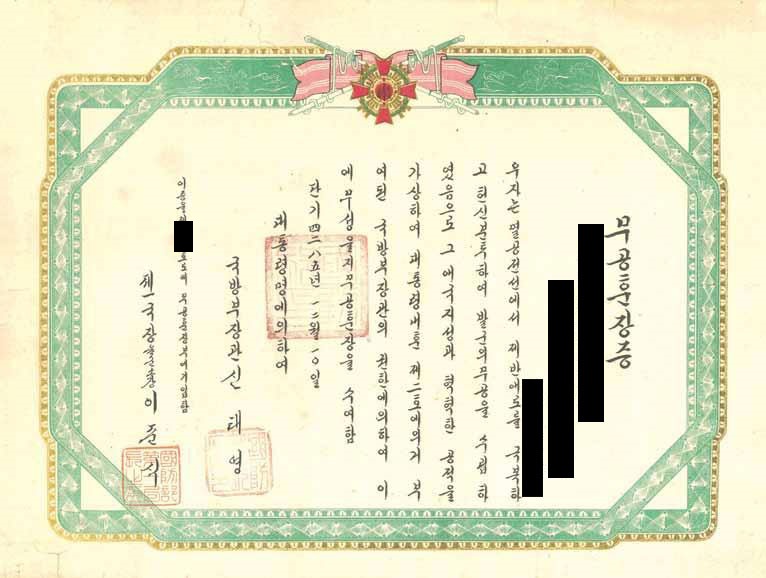
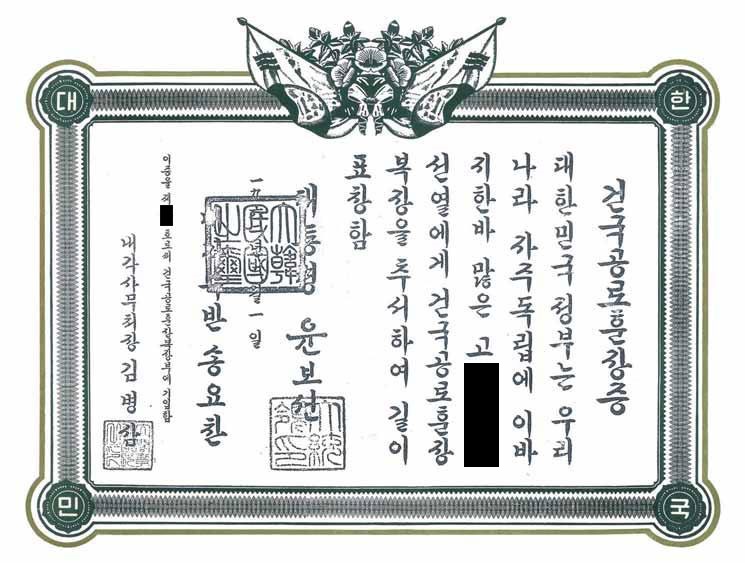

Used from Jan. 1, 1963 to Dec. 16, 1963.
On Dec. 17, 1963, color was added to the flags and Mugunghwa flower and petals.
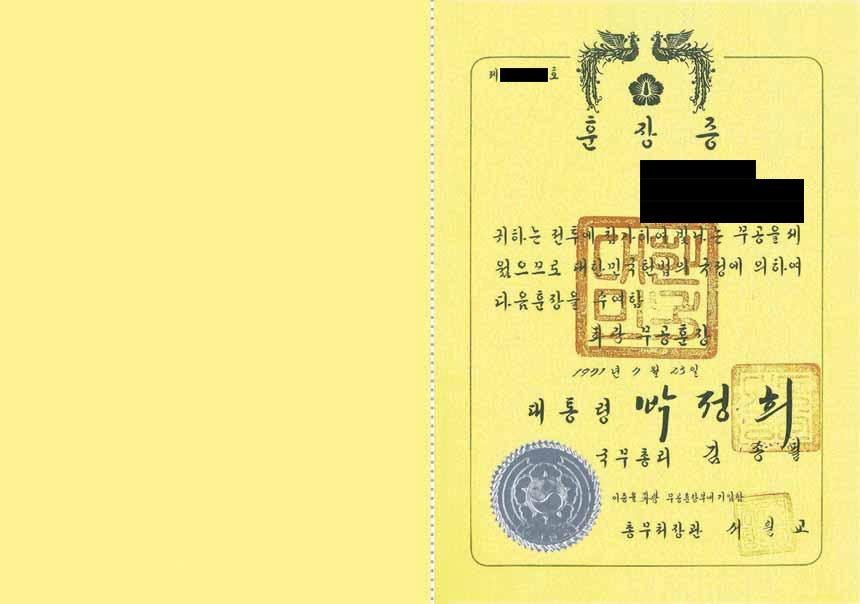
Used from Dec. 19, 1969 until his assassination on Oct. 26, 1979.
Size 42 × 30 cm.
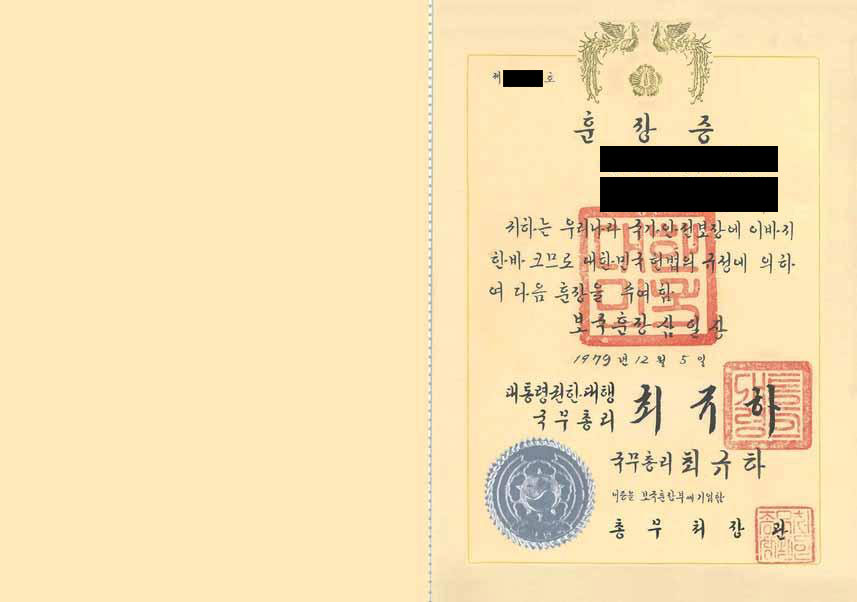
Used from Oct. 27, 1979 to Dec. 6, 1979.
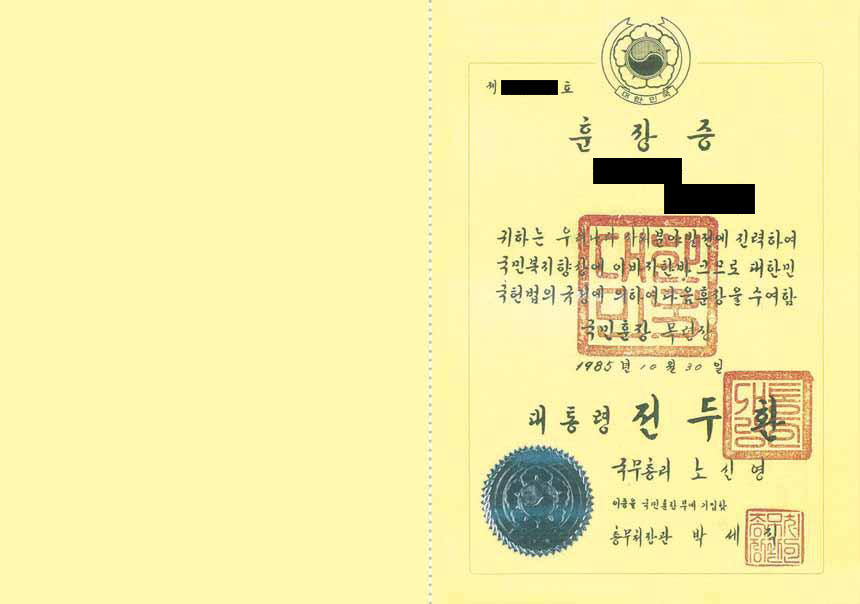
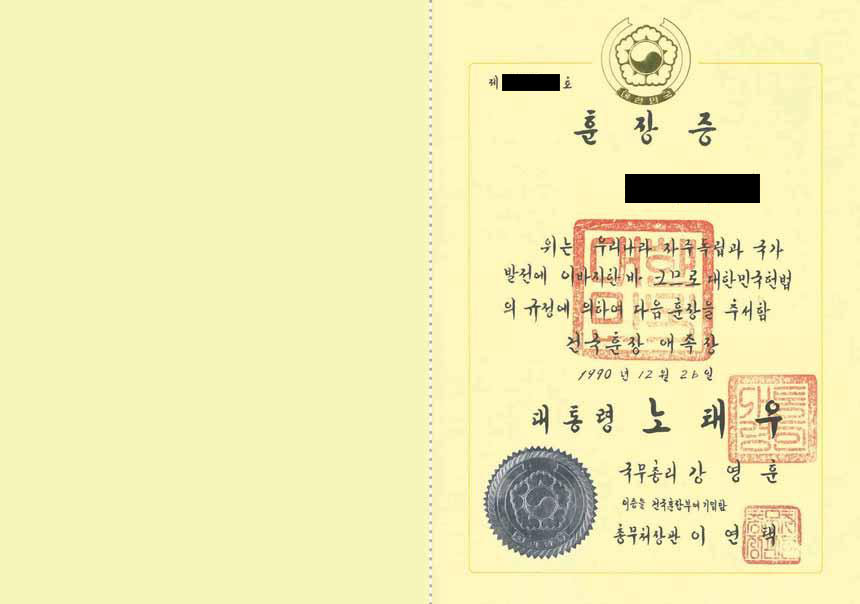
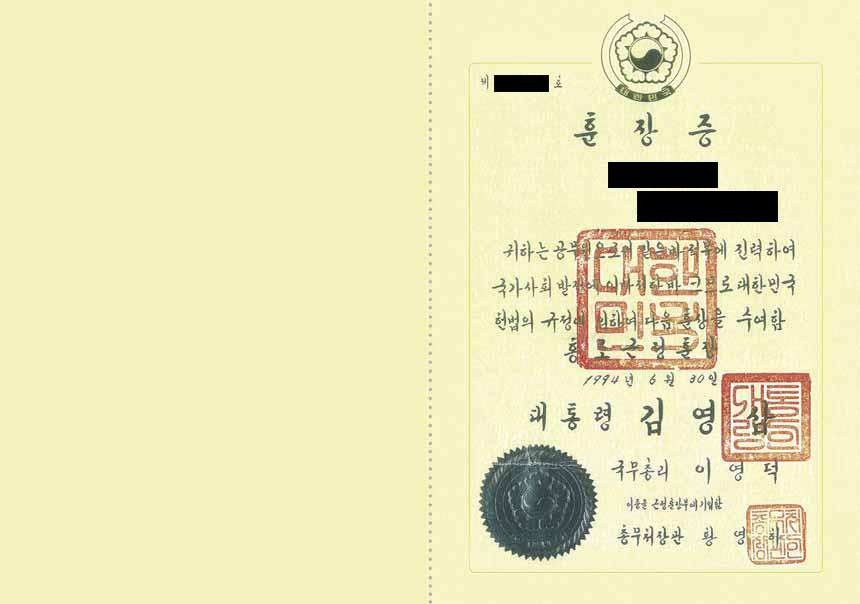
Used by Kim Dae-jung starting on Feb. 25, 1998.
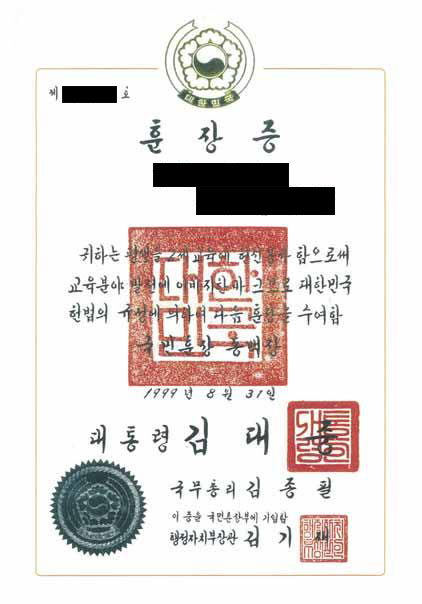
First used on Feb. 1, 1999.
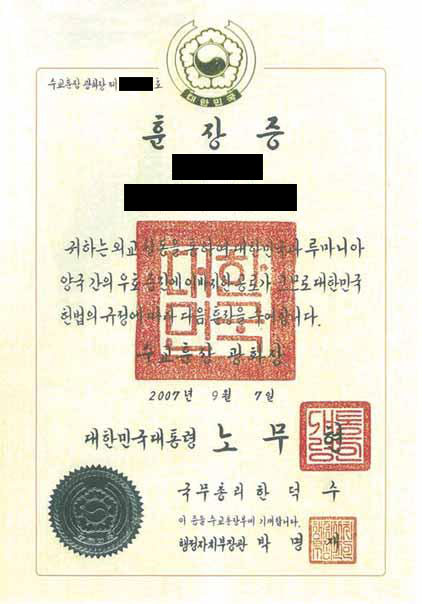
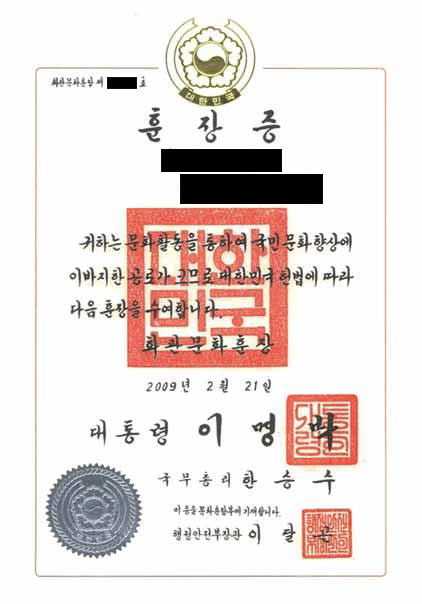
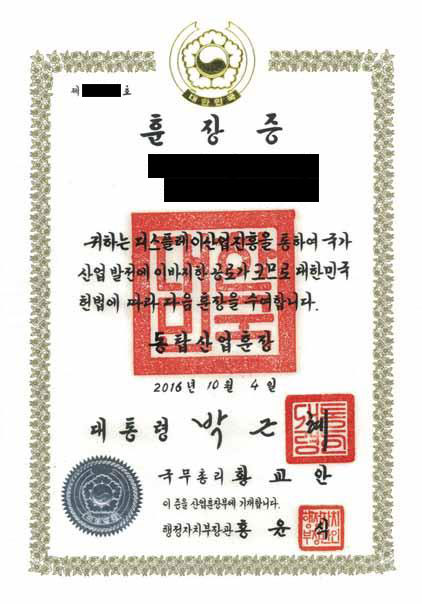
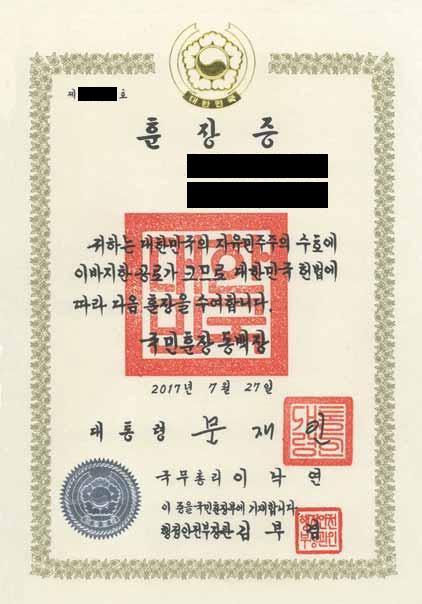
Signatures:
List of Presidents and Acting Presidents
- Syngman Rhee 이승만 (李承晩 1875–1965) President July 24, 1948, to April 26, 1960
- Ho Chong 허정 (許政 1896–1988) Acting President April 27, 1960, to June 15, 1960
- Kwak Sang-hoon 곽상훈 (郭尙勳 1896–1980) Acting President June 16, 1960, to June 23, 1960
- Ho Chong 허정 (許政 1896–1988) Acting President June 23, 1960, to August 7, 1960
- Baek Nak-jun 백낙준 (白樂濬 1895–1985) Acting President August 8, 1960, to August 12, 1960
- Yun Posun 윤보선 (尹潽善 1897–1990) President August 13, 1960, to March 24, 1962
- Park Chung Hee (General) 박정희 (朴正熙 1917–1979) Chairman of the SCNR March 24, 1962, to December 16, 1963
- Park Chung Hee 박정희 (朴正熙 1917–1979) President December 17, 1963, to October 26, 1979
- Choi Kyu-hah 최규하 (崔圭夏 1919–2006) President October 26, 1979, to August 16, 1980
- Park Choong-hoon 박충훈 (朴忠勳 1919–2001) Acting President August 16, 1980, to August 31, 1980
- Chun Doo-hwan 전두환 (全斗煥 1931–2021) President September 1, 1980, to February 24, 1988
- Roh Tae-woo 노태우 (盧泰愚 1932–2021) President February 25, 1988, to February 24, 1993
- Kim Young-sam 김영삼 (金泳三 1927–2015) President February 25, 1993, to February 24, 1998
- Kim Dae-jung 김대중 (金大中 1924–2009) President February 25, 1998, to February 24, 2003
- Roh Moo-hyun 노무현 (盧武鉉 1946–2009) President February 25, 2003 to February 24, 2008
- Lee Myung-bak 이명박 (李明博 1941 – ) President February 25, 2008 to February 24, 2013
- Park Geun-hye 박근혜 (朴槿惠 1952 -) President February 25, 2013 to March 10, 2017
- Hwang Kyo-ahn 황교안 (黃敎安 1957 – ) Acting President December 9, 2016 to May 9, 2017
- Moon Jae-in문재인 (文在寅 1953 – ) President May 10, 2017 to May 9, 2022
- Yoon Suk Yeol 윤석열 (尹錫悅 1960 – ) President May 10, 2022, current Incumbent
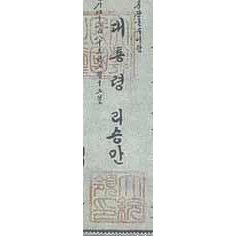
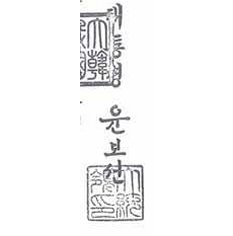











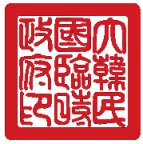
Great Seal of the Republic of Korea 대한민국 국새 (大韓民國 國璽)
On Korean documents, the largest seal stamp is the Korean National Seal. The Great Seal of the Republic of Korea is also known as the National Seal. It is used on the full text of the promulgation of the Constitution, letters of appointment to government officials of grade 5 or higher, important diplomatic documents, and Decoration and Award documents, etc. The seal is controlled under a Presidential Decree entitled 국새규정, which translates as “National Seal Regulations” or “Great Seal Regulations”. The national seal is managed by the Minister of Public Administration and Security 행정안전부장관.
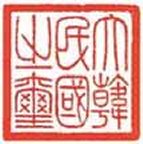
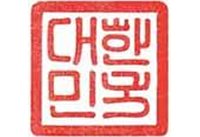

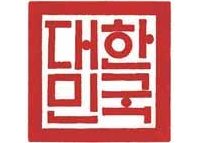
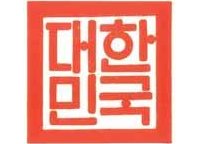
- The 1st Great Seal was produced at Cheonsangdang in Chungmuro, Seoul in 1948. It was used from May 5, 1949, until December 31, 1962. The material was silver, and the face was 6.06 cm square. The text is engraved in Chinese characters 大韓民國之璽 (Seal of the Republic of Korea). The whereabouts of the seal are currently unknown, and the government has been searching since 2004. There is a controversy over whether the handle 인뉴 (印鈕) is a dragon (용) or a sapsal dog (삽살개).
- The 2nd Great Seal was used from January 1, 1963, to January 31, 1999. The material is silver, it is 7 cm square and weighs 2.0 kg. The text is engraved in Korean script Hangul with the words 대한민국 “Republic of Korea”. The handle is shaped like a turtle. The Great Seal is currently in the possession of the National Archives.
- The 3rd Great Seal was used from February 1, 1999, to February 21, 2008. The material is gold, the face is 10.1 cm square, the weight is 2.15 kg and the handle is a phoenix 봉황. The inscription is engraved in Korean script Hangul with the words 대한민국 “Republic of Korea”. It uses a Hunminjeongeum font. In 2005, the Great Seal was found to have cracks, the 3rd National Seal, was repaired and used temporarily from Nov. 30, 2010 to Oct. 24, 2011 when the 5th National Seal was completed.
- The 4th Great Seal was used from February 22, 2008, to November 30, 2010. The material is gold, the face is 9.9 cm square, and the weight is 2.9 kg. The inscription depicts the Republic of Korea in Hangul using the Hunminjeongeum font, and the handle is a phoenix. When cracks were discovered in the 3rd National Seal, it was decided to produce a new national seal in October 2005. The National Seal Production Advisory Committee was formed in March 2006, and Min Hong-gyu was selected as the national seal maker through a contest process. Along with the national seal, 16 types of national seal decoration items were produced by craftsmen in their relevant fields. However, in September 2010, the 4th Great Seal was scrapped when Min Hong-gyu was indicted on charges of fraud. He made and delivered the Great Seal using modern manufacturing methods, even though he had contracted with the government to make the Great Seal using traditional techniques.
- The 5th Great Seal has been in use since October 25, 2011. The material is a gold alloy composed of gold, silver, copper, zinc, and iridium, the size is 10.4 cm square, and the weight is 3.38 kg. The inscription depicts the Republic of Korea in Hangul using the Hunminjeongeum font, and the handle is a phoenix and the Rose of Sharon (Mugunghwa). It was decided to produce the 5th national seal on October 29, 2010, and the Korea Institute of Science and Technology (KIST) was selected as the producer of the national seal through competitive bidding. KIST began production on June 16, 2011, and the Great Seal was delivered on September 30th. The inside of the Great Seal was hollowed out and the seal and seal were made by casting them all at once without separating them. Iridium, a rare metal, was added to prevent cracking. To prevent commercial use of the national seal, an application for design registration was applied for with the Korean Intellectual Property Office on September 9, 2011. The design application number for the national seal is 30-2011-0037989. The Defense Agency for Technology and Quality scientifically verified the quality of the national.
